climate control PONTIAC BONNEVILLE 1994 Owners Manual
[x] Cancel search | Manufacturer: PONTIAC, Model Year: 1994, Model line: BONNEVILLE, Model: PONTIAC BONNEVILLE 1994Pages: 290, PDF Size: 14.75 MB
Page 88 of 290
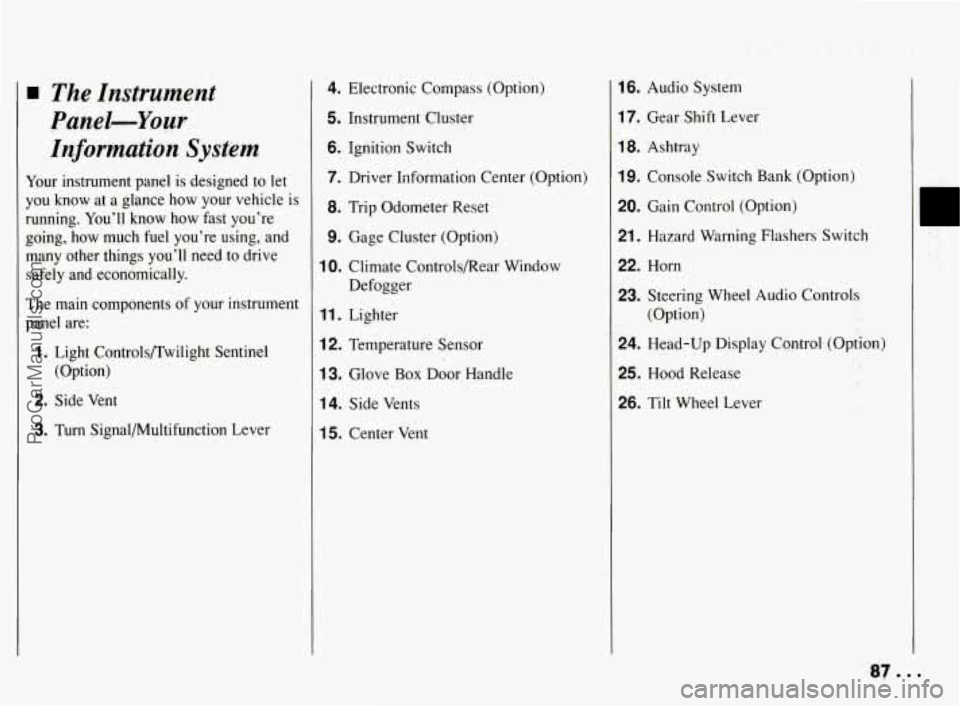
The Instrument
Panel-Your
Information System
Your instrument panel is designed to let
you
know at a glance how your vehicle is
running.
You’ll know how fast you’re
going, how much fuel you’re using, and
many other things you’ll need to drive
safely and economically;
.. .L .
The main components of your instrument
panel are:
1. Light Controls/Twilight Sentinel
(Option)
2. Side Vent
3. Turn Signal/Multifunction Lever
4. Electronic Compass (Option)
5. Instrument Cluster
6. Ignition Switch
7. Driver Information Center (Option)
8. Trip Odometer Reset
9. Gage Cluster (Option)
10. Climate Controls/Rear Window
Defogger
11. Lighter
12. Temperature Sensor
13. Glove Box Door Handle
14. Side Vents
15. Center Vent
16. Audio System
17. Gear Shift Lever
18. Ashtray
19. Console Switch Bank (Option)
20. Gain Control (Option)
21. Hazard Warning Flashers Switch
22. Horn
23. Steering Wheel Audio Controls
(Option)
24. Head-Up Display Cqntrol. (Option)
25. Hood Release
26. Tilt Wheel Lever
I
ProCarManuals.com
Page 97 of 290
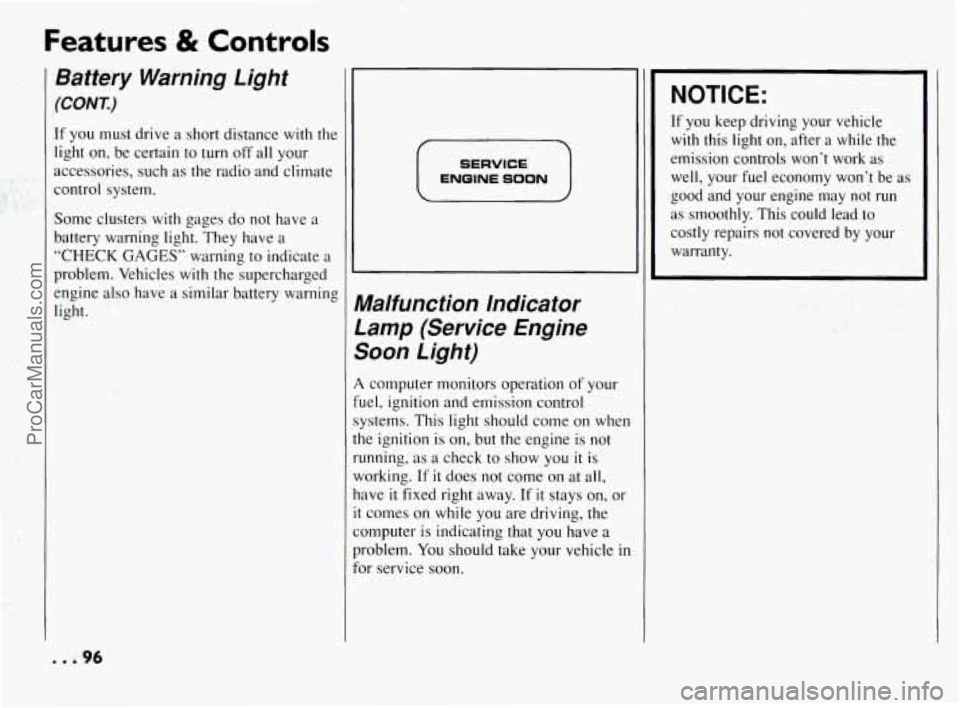
Features & Controls
Battery Warning Light
(CONT.)
If you must drive a short distance with the
light
on, be certain to turn off all your
accessories, such as
the radio and climate
control system.
Some clusters with gages do not have a
battery warning light. They have
a
“CHECK GAGES” warning to indicate a
problem. Vehicles with the supercharged
engine also have a similar battery warning
light.
SERVICE
ENGINE SOON
Malfunction Indicator
.amp (Service Engine
Soon Light)
1 computer monitors operation of your
uel, ignition and emission control
ystems. This light should come on when
he ignition is on, but the engine is not
unning, as a check
to show you it is
iorking. If
it does not come on at all,
ave
it fixed right away. If it stays on, or
: comes on while you are driving, the
omputer is indicating that you have
a
roblem. You should take your vehicle in
x- service soon.
NOTICE:
If you keep driving your vehicle
with this light on, after a while the
emission controls won’t work as
well,
your fuel economy won’t be as
good and your engine may not
run
as smoothly. This could lead to
costly repairs not covered by your
warranty.
... 96
ProCarManuals.com
Page 112 of 290
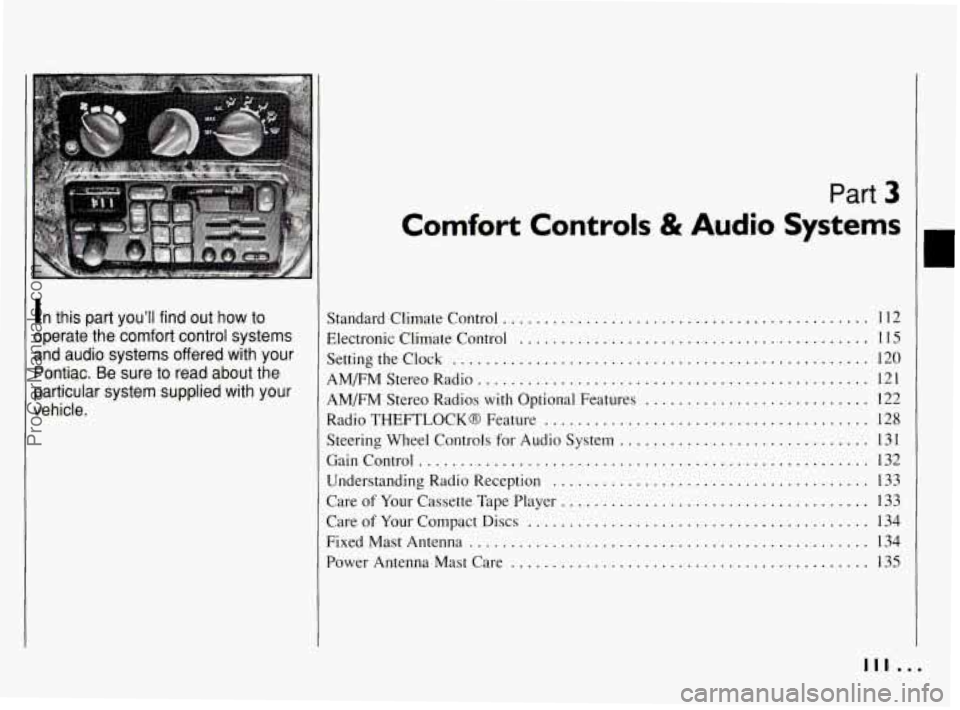
In this part you’ll find out how to
operate the comfort control systems
and audio systems offered with your
Pontiac
. Be sure to read about the
particular system supplied with your
............................................ Standard Climate Control 112
Settingtheclock
.................................................. 120
AM/FM Stereo Radio 121
Electronic
Climate Control
.......................................... 115
AM/FM Stereo Radios
with Optional Features ........................... 122
Radio
THEFTLOCK8 Feature ....................................... 128
Steering Wheel Controls for Audio System
.............................. 131
Gaincontrol
.................................................... 132
Understanding Radio Reception
........ ....................... 133
Care
of Your Cassette Tape Player ....... ....................... 133
Care of Your Compact Discs ......................................... 134
Power Antenna Mast Care
.......... .............................. 135
...............................................
FixedMastAntenna ................................................ 134
111 .I
ProCarManuals.com
Page 113 of 290
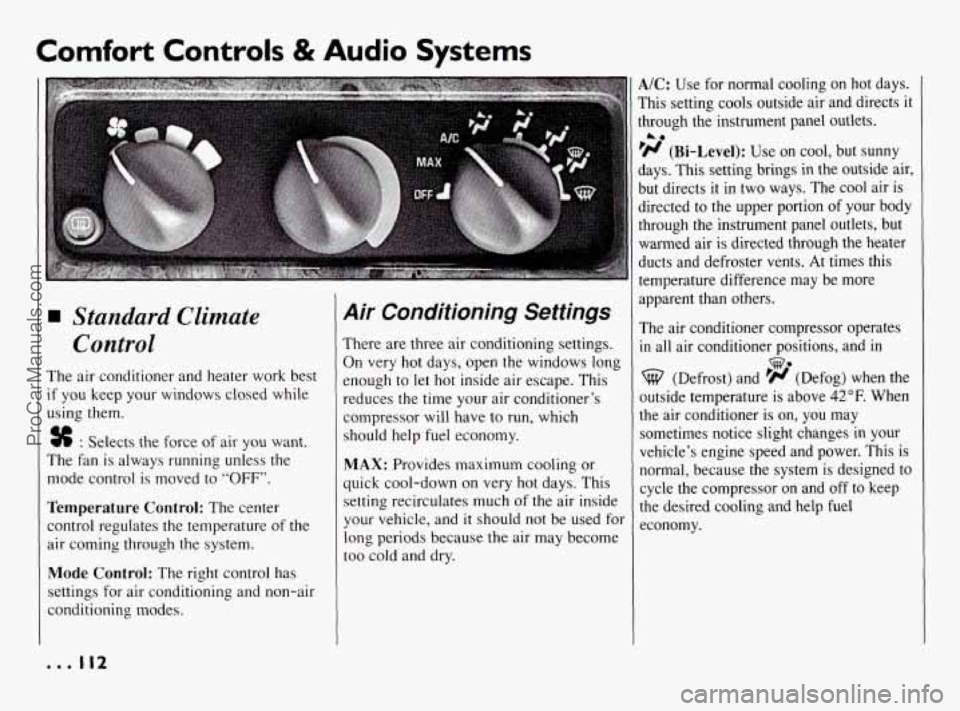
Comfort Controls & Audio Systems
Standard Climate
Control
The air conditioner and heater work best
if you keep your windows closed while
using them.
% : Selects the force of air you want.
The fan is always running unless the
mode control is moved to
“OFF”.
Temperature Control: The center
control regulates the temperature of the
air coming through the system.
Mode Control: The right control has
settings for air conditioning and non-air
conditioning modes.
Air Conditioning Settings
There are three air conditioning settings.
On very hot days, open the windows long
enough
to let hot inside air escape. This
reduces the time your air conditioner’s
compressor will have to run, which
should help fuel economy.
MAX: Provides maximum cooling or
quick cool-down
on very hot days. This
setting recirculates much of the air inside
your vehicle, and
it should not be used for
long periods because the air may become
too cold and dry.
A/C: Use for normal cooling on hot days.
This setting cools outside air and directs
it
through the instrument panel outlets.
‘H (Bi-Level): Use on cool, but sunny
days. This setting brings in the outside air,
but directs it in two ways. The cool air is
directed to the upper portion
of your body
through the instrument panel outlets, but
warmed air
is directed through the heater
ducts and defroster vents. At times this
temperature difference may be more
apparent than others.
The air conditioner compressor operates
in all air conditioner positions, and in
A0
we
(Defrost) and ’# (Defog) when the
outside temperature is above
42°F. When
the air conditioner is on,
you may
sometimes notice slight changes
in your
vehicle’s engine speed and power. This is
normal, because the system is designed to
cycle the compressor
on and off to keep
the desired cooling and help fuel
economy.
... 112
ProCarManuals.com
Page 114 of 290
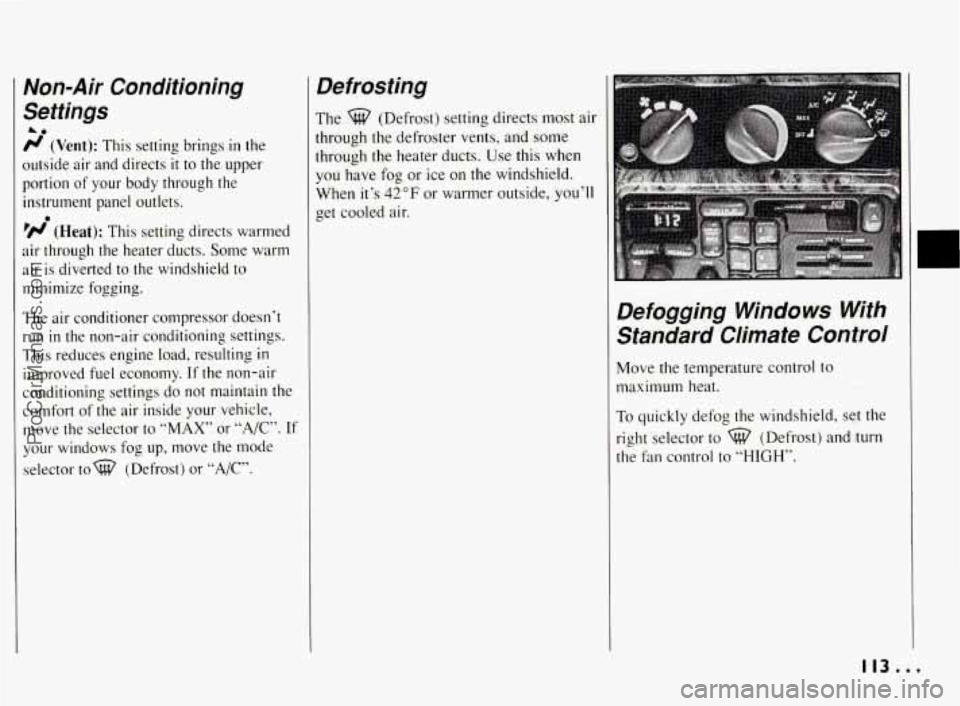
Non-Air Conditioning
Settings
A0
r/ (Vent): This setting brings in the
outside air and directs
it to the upper
portion of your body through the
instrument panel outlets.
’N (Heat): This setting directs warmed
air through the heater ducts. Some warm
air is diverted to the windshield to
minimize fogging.
The air conditioner compressor doesn’t
run in the non-air conditioning settings.
This reduces engine load, resulting
in
improved fuel economy. If the non-air
conditioning settings do not maintain the
comfort of the air inside your vehicle,
move the selector to
“MAX” or “A/,”. If
your windows fog up, move the mode
selector tow (Defrost) or
“A/C”.
0
Defrosting
The %? (Defrost) setting directs most air
through the defroster vents, and some
through the heater ducts. Use this when
you have fog or ice on the windshield.
When it’s
42°F or warmer outside, you’ll
get cooled air.
Defogging Windows With Standard Climate Control
Move the temperature control to
maximum heat.
To quickly defog the windshield, set the
right selector to
%? (Defrost) and turn
the fan control to “HIGH’’.
113...
ProCarManuals.com
Page 115 of 290
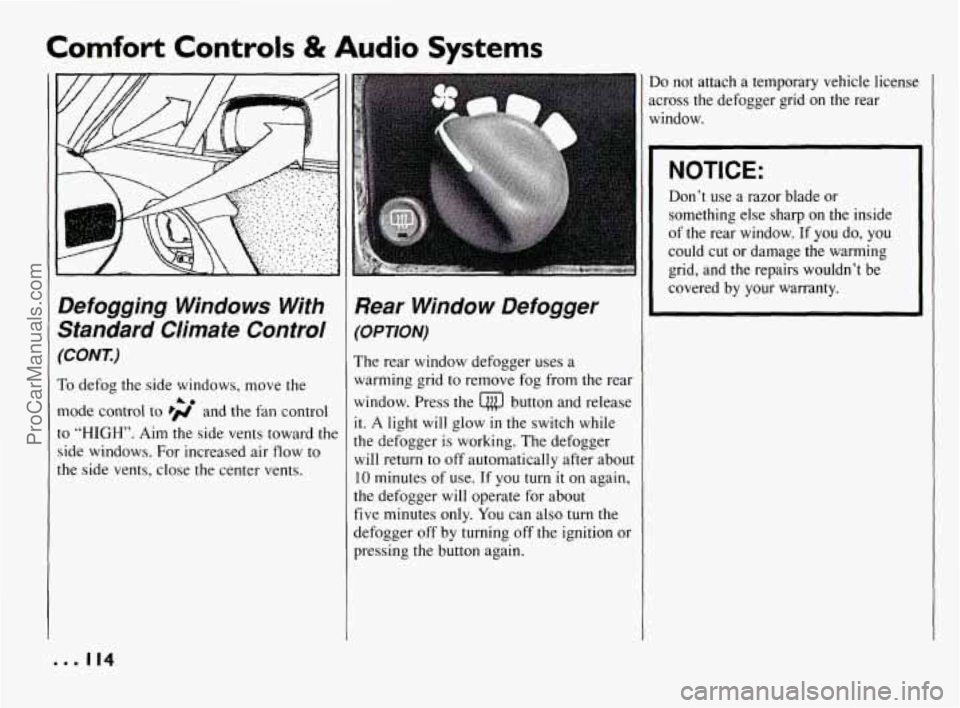
Comfort Controls & Audio Systems
Defogging Windows With
Standard Climate Control
(CONT.)
To defog the side windows, move the
mode control to
Ffl and the fan control
to “HIGH”. Aim the side vents toward the
side windows. For increased air flow to
the side vents. close the center vents.
A0
.. 114
Rear Window Defogger
(OPTION)
The rear window defogger uses a
warming grid to remove fog from the rear
window. Press the
@ button and release
it. A light will glow
in the switch while
the defogger
is working, The defogger
will return to off automatically after about
10 minutes of use. If you turn it on again,
the defogger
will operate for about
five minutes only.
You can also turn the
defogger off by turning off the ignition or
pressing the button again.
Do not attach a temporary vehicle license
across the defogger grid on the rear
window.
NOTICE:
Don’t use a razor blade or
something else sharp on the inside
of the rear window. If
you do, you
could cut or damage the warming
grid, and the repairs wouldn’t be
covered by your warranty.
ProCarManuals.com
Page 117 of 290
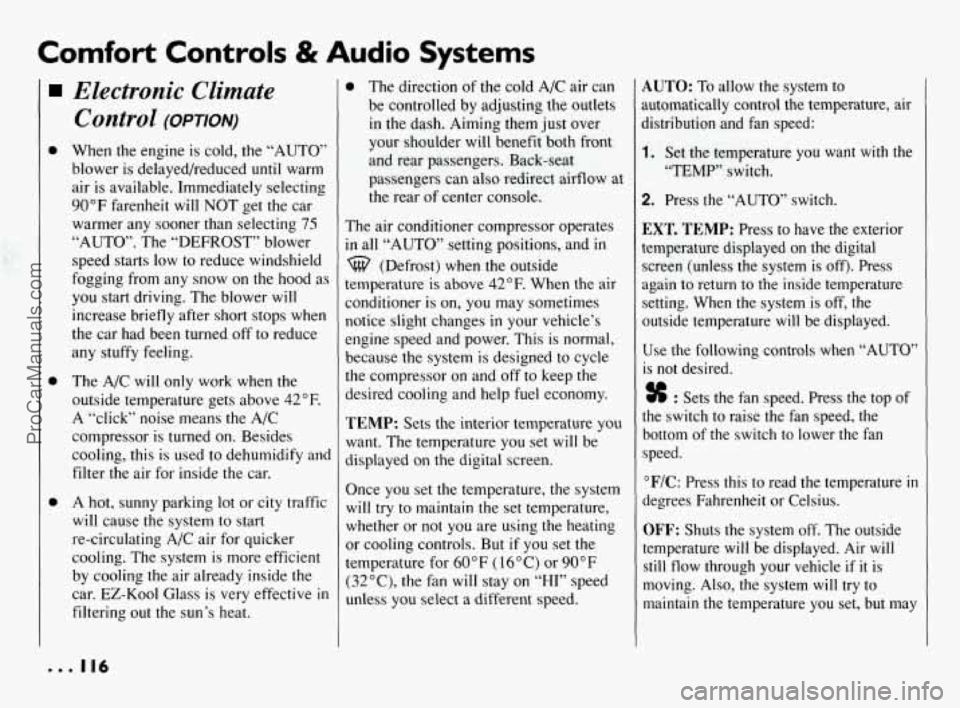
Comfort Controls & Audio Systems
0
0 0
Electronic Climate Control
(OPTION)
When the engine is cold, the “AUTO’
blower is delayed/reduced until warm
air is available. Immediately selecting
90°F farenheit will NOT get the car
warmer any sooner than selecting
75
“AUTO”. The “DEFROST” blower
speed starts low to reduce windshield
fogging from any snow on the hood as
you start driving. The blower will
increase briefly after short stops when
the car had been turned
off to reduce
any stuffy feeling.
The A/C will only work when the
outside temperature gets above
42°F.
A “click” noise means the A/C
compressor is turned on. Besides
cooling, this is used to dehumidify and
filter the air for inside the car.
A hot, sunny parking lot or city traffic
will cause the system to start
re-circulating A/C air for quicker
cooling. The system is more efficient
by cooling the air already inside the
car.
EZ-Kool Glass is very effective in
filtering out the sun’s heat.
0 The direction of the cold A/C air can
be controlled by adjusting the outlets
in the dash. Aiming them just over
your shoulder will benefit both front
and rear passengers. Back-seat
passengers can also redirect airflow at
the rear of center console.
The air conditioner compressor operates
in all “AUTO” setting positions, and in
%? (Defrost) when the outside
temperature is above
42°F. When the air
conditioner is on, you may sometimes
notice slight changes in your vehicle’s
engine speed and power. This is normal,
because the system
is designed to cycle
the compressor on and off to keep the
desired cooling and help fuel economy.
TEMP: Sets the interior temperature you
want. The temperature you set will be
displayed on the digital screen.
Once you set the temperature, the system
will try to maintain the set temperature,
whether or not
you are using the heating
or cooling controls. But
if you set the
temperature for
60°F ( 16°C) or 90°F
(32”C), the fan will stay on “HI” speed
unless you select a different speed.
AUTO: To allow the system to
automatically control the temperature, air
Jistribution and fan speed:
1. Set the temperature you want with the
“TEMP” switch.
2. Press the “AUTO” switch.
EXT. TEMP: Press to have the exterior
temperature displayed
on the digital
screen (unless the system is off). Press
again to return to the inside temperature
setting. When the system is off, the
outside temperature will be displayed.
Use the following controls when “AUTO’
is not desired.
% : Sets the fan speed. Press the top of
the switch to raise the fan speed, the
bottom of the switch to lower the fan
speed.
“F/C: Press this to read the temperature in
degrees Fahrenheit or Celsius.
OFF: Shuts the system off. The outside
temperature will be displayed. Air
will
still flow through your vehicle if it is
moving. Also, the system will try to
maintain the temperature you set, but,may
... 116
ProCarManuals.com
Page 118 of 290
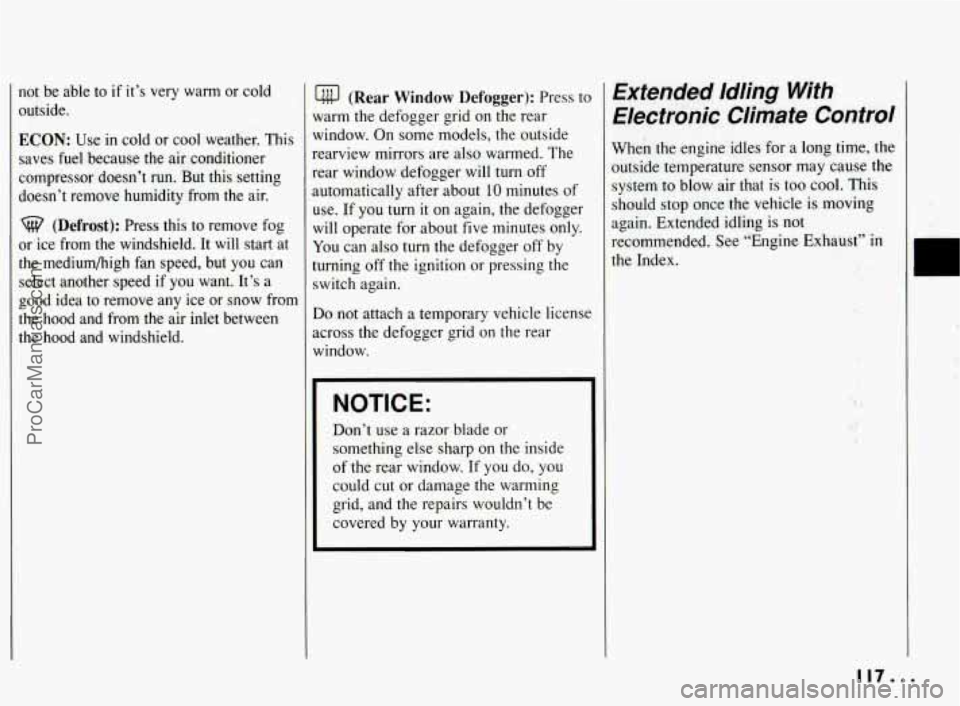
not be able to if it’s very warm or cold
outside.
ECON: Use in cold or cool weather. This
saves fuel because the air conditioner
compressor doesn’t run. But this setting
doesn’t remove humidity from the air.
(Defrost): Press this to remove fog
or ice from the windshield. It will start at
the mediumhigh fan speed, but you can
select another speed
if you want. It’s a
good idea to remove any ice or snow from
the hood and from the air inlet between
the hood and windshield.
(Rear Window Defogger): Press tc
warm the defogger grid on the rear
window. On some models, the outside
rearview mirrors are also warmed. The
rear window defogger will turn off
automatically after about 10 minutes of
use. If you turn it on again, the defogger
will operate for about five minutes only.
You can also turn the defogger off by
turning off the ignition or pressing the
switch again.
Do not attach a temporary vehicle licensc
across the defogger grid on the rear
window.
NOTICE:
Don’t use a razor blade or
something else sharp on the inside
of the rear window.
If you do, you
could cut or damage the warming
grid, and the repairs wouldn’t be
covered by your warranty.
Extended Idling With
Electronic Climate Control
When the engine idles for a long time, the
outside temperature sensor may cause the
system to blow air that is too cool.
This
should stop once the vehicle is moving
again. Extended idling is not
recommended, See “Engine Exhaust’’
in
the Index.
11/...
ProCarManuals.com
Page 120 of 290
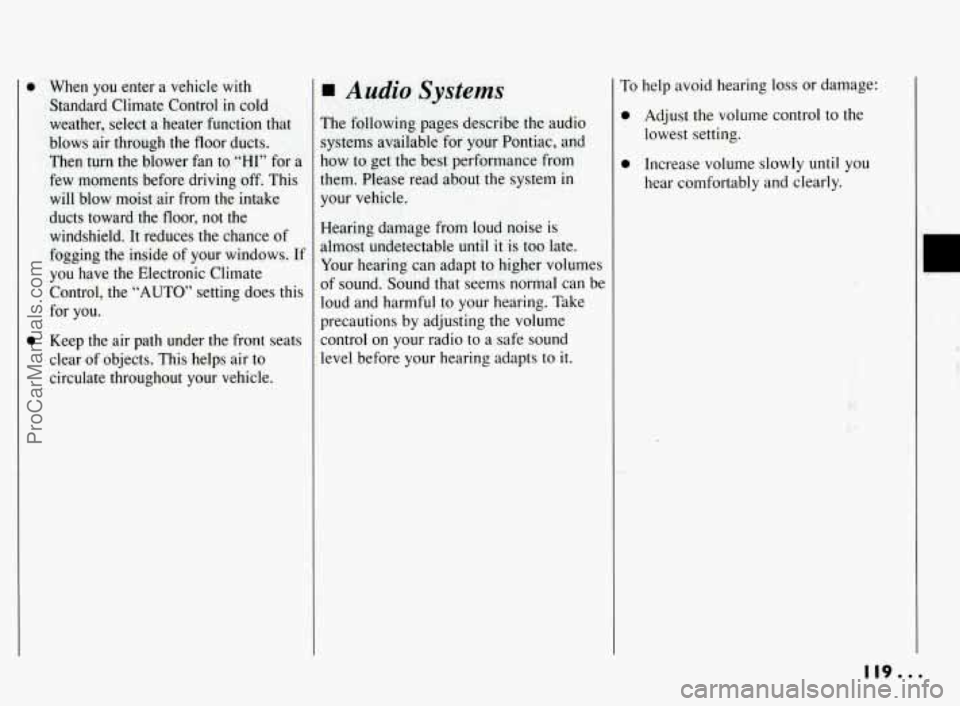
0
0
When you enter a vehicle with
Standard Climate Control in cold
weather, select a heater function that
blows air through the floor ducts.
Then
turn the blower fan to. “HI” for a
few moments before driving off. This
will blow moist air from the intake
ducts toward the floor, not the
windshield. It reduces the chance of
fogging the inside of your windows. If
you have the Electronic Climate
Control, the “AUTO” setting does this
for you.
Keep the air path under the front seats
clear of objects. This helps air to
circulate throughout your vehicle.
r-,ldio Systems
The following pages describe the audio
systems available for your Pontiac, and
how to get the best performance from
them. Please read about the system
in
your vehicle.
Hearing damage from loud noise is
almost undetectable
until it is too late.
Your hearing can adapt to higher volumes
of sound. Sound that seems normal can be
loud and harmful to your hearing. Take
precautions by adjusting the volume
control on your radio to a safe sound
level before your hearing adapts to it. To
help avoid hearing loss or damage:
0
0 Adjust the volume control to the
lowest setting.
Increase volume slowly
until you
hear comfortably and clearly.
119.. .
ProCarManuals.com
Page 228 of 290
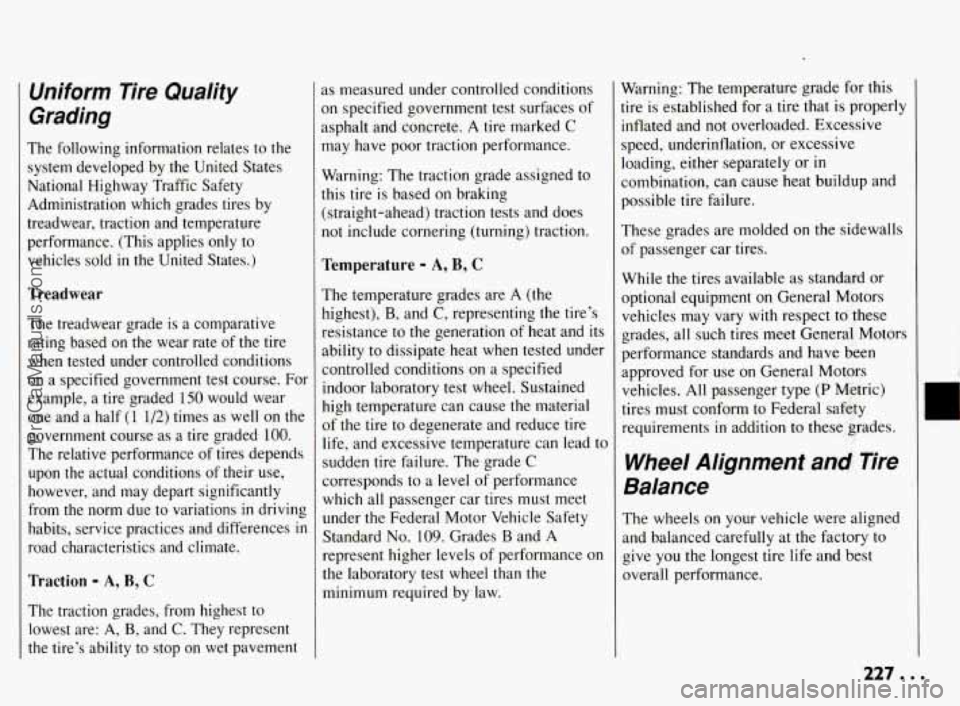
Uniform Tire Quality
Grading
The following information relates to the
system developed by the United States
National Highway Traffic Safety
Administration which grades tires by
treadwear, traction and temperature
performance. (This applies only to
vehicles sold
in the United States.)
Treadwear
The treadwear grade is a comparative
rating based on the wear rate of the tire
when tested under controlled conditions
on a specified government test course. For
example, a tire graded
150 would wear
one and a half
(1 1/2) times as well on the
government course as a tire graded 100.
The relative performance of tires depends
upon the actual conditions of their use,
however, and may depart significantly
from the norm due to variations in driving
habits, service practices and differences
in
road characteristics and climate.
Traction - A, B, C
The traction grades, from highest to
lowest are: A,
B, and C. They represent
i the tire's ability to stop on wet pavement as measured under controlled conditions
on specified government test surfaces
of
asphalt and concrete. A tire marked
C
may have poor traction performance.
Warning: The traction grade assigned to
this tire is based on braking (straight-ahead) traction tests and does
not include cornering (turning) traction.
Temperature - A, B, C
The temperature grades are A (the
highest),
B, and C, representing the tire's
resistance to the generation of heat and its
ability
to dissipate heat when tested under
controlled conditions on a specified
indoor laboratory test wheel. Sustained
high temperature can cause the material
of the tire to degenerate and reduce tire
life, and excessive temperature can lead
to
sudden tire failure. The grade C
corresponds to a level of performance
which all passenger car tires must meet
under the Federal Motor Vehicle Safety
Standard No.
109. Grades B and A
represent higher levels of performance on
the laboratory test wheel than the minimum required by law. Warning:
The temperature grade for this
tire
is established for a tire that is properly
inflated and not overloaded. Excessive
speed, underinflation, or excessive
loading, either separately or in
combination, can cause heat buildup and
possible tire failure.
These grades are molded on the sidewalls
of passenger car tires.
While the tires available as standard or
optional equipment on General Motors
vehicles may vary with respect to these
grades, all such tires meet General Motors
performance standards and have been
approved for use on General Motors
vehicles. All passenger type
(P Metric)
tires must conform
to Federal safety
requirements in addition
to these grades.
Wheel Alignment and Tire
Balance
The wheels on your vehicle were aligned
and balanced carefully at the factory to
give you the longest tire life and best
overall performance.
ProCarManuals.com